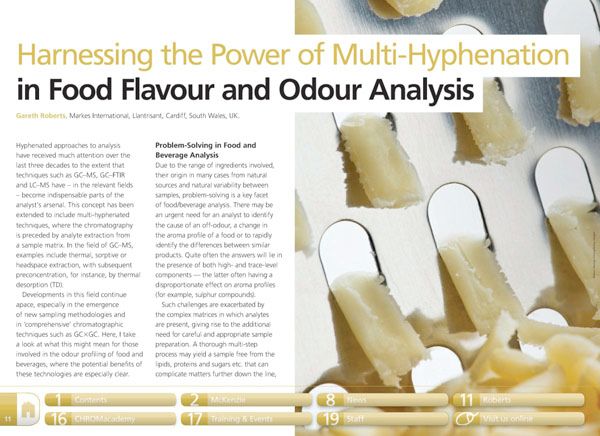Harnessing the Power of Multi-Hyphenation in Food Flavour and Odour Analysis
Hyphenated approaches to analysis have received much attention over the last three decades to the extent that techniques such as GC?MS, GC?FTIR and LC?MS have ? in the relevant fields ? become indispensable parts of the analyst?s arsenal. This concept has been extended to include multi-hyphenated techniques, where the chromatography is preceded by analyte extraction from a sample matrix. In the field of GC?MS, examples include thermal, sorptive or headspace extraction, with subsequent preconcentration, for instance, by thermal desorption (TD).

Hyphenated approaches to analysis have received much attention over the last three decades to the extent that techniques such as GC–MS, GC–FTIR and LC–MS have – in the relevant fields – become indispensable parts of the analyst’s arsenal. This concept has been extended to include multi-hyphenated techniques, where the chromatography is preceded by analyte extraction from a sample matrix. In the field of GC–MS, examples include thermal, sorptive or headspace extraction, with subsequent preconcentration, for instance, by thermal desorption (TD).
Analytical Challenges in Measuring Migration from Food Contact Materials
November 2nd 2015Food contact materials contain low molecular weight additives and processing aids which can migrate into foods leading to trace levels of contamination. Food safety is ensured through regulations, comprising compositional controls and migration limits, which present a significant analytical challenge to the food industry to ensure compliance and demonstrate due diligence. Of the various analytical approaches, LC-MS/MS has proved to be an essential tool in monitoring migration of target compounds into foods, and more sophisticated approaches such as LC-high resolution MS (Orbitrap) are being increasingly used for untargeted analysis to monitor non-intentionally added substances. This podcast will provide an overview to this area, illustrated with various applications showing current approaches being employed.
University of Rouen-Normandy Scientists Explore Eco-Friendly Sampling Approach for GC-HRMS
April 17th 2025Root exudates—substances secreted by living plant roots—are challenging to sample, as they are typically extracted using artificial devices and can vary widely in both quantity and composition across plant species.
Sorbonne Researchers Develop Miniaturized GC Detector for VOC Analysis
April 16th 2025A team of scientists from the Paris university developed and optimized MAVERIC, a miniaturized and autonomous gas chromatography (GC) system coupled to a nano-gravimetric detector (NGD) based on a NEMS (nano-electromechanical-system) resonator.









